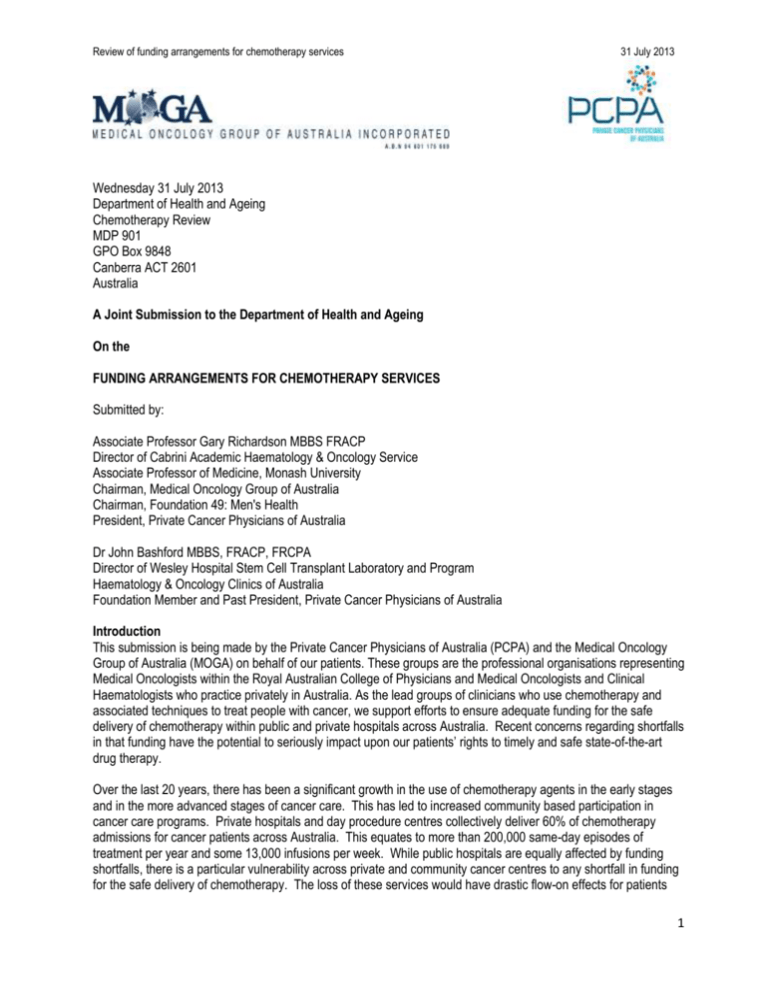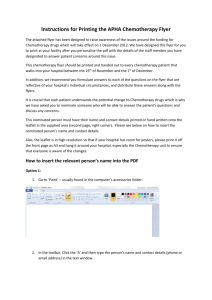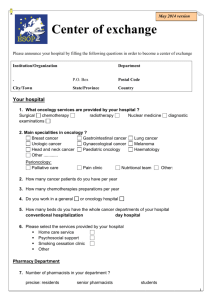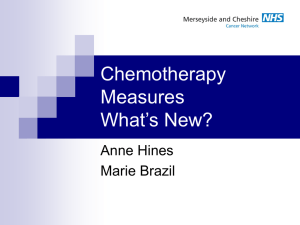Senate Enquiry - Department of Health
advertisement

Review of funding arrangements for chemotherapy services 31 July 2013 Wednesday 31 July 2013 Department of Health and Ageing Chemotherapy Review MDP 901 GPO Box 9848 Canberra ACT 2601 Australia A Joint Submission to the Department of Health and Ageing On the FUNDING ARRANGEMENTS FOR CHEMOTHERAPY SERVICES Submitted by: Associate Professor Gary Richardson MBBS FRACP Director of Cabrini Academic Haematology & Oncology Service Associate Professor of Medicine, Monash University Chairman, Medical Oncology Group of Australia Chairman, Foundation 49: Men's Health President, Private Cancer Physicians of Australia Dr John Bashford MBBS, FRACP, FRCPA Director of Wesley Hospital Stem Cell Transplant Laboratory and Program Haematology & Oncology Clinics of Australia Foundation Member and Past President, Private Cancer Physicians of Australia Introduction This submission is being made by the Private Cancer Physicians of Australia (PCPA) and the Medical Oncology Group of Australia (MOGA) on behalf of our patients. These groups are the professional organisations representing Medical Oncologists within the Royal Australian College of Physicians and Medical Oncologists and Clinical Haematologists who practice privately in Australia. As the lead groups of clinicians who use chemotherapy and associated techniques to treat people with cancer, we support efforts to ensure adequate funding for the safe delivery of chemotherapy within public and private hospitals across Australia. Recent concerns regarding shortfalls in that funding have the potential to seriously impact upon our patients’ rights to timely and safe state-of-the-art drug therapy. Over the last 20 years, there has been a significant growth in the use of chemotherapy agents in the early stages and in the more advanced stages of cancer care. This has led to increased community based participation in cancer care programs. Private hospitals and day procedure centres collectively deliver 60% of chemotherapy admissions for cancer patients across Australia. This equates to more than 200,000 same-day episodes of treatment per year and some 13,000 infusions per week. While public hospitals are equally affected by funding shortfalls, there is a particular vulnerability across private and community cancer centres to any shortfall in funding for the safe delivery of chemotherapy. The loss of these services would have drastic flow-on effects for patients 1 Review of funding arrangements for chemotherapy services 31 July 2013 and for the public health system. Equally, inadequate pharmaceutical benefit schedule funding for chemotherapy would reduce funds for service delivery in other areas of cancer care across state public hospital units exacerbating the impact of private hospital transfers. For cancer patients these changes could cause substantial increases in direct and indirect cost of their care, the need to travel further to receive treatment, delays in life saving treatment if they move to an already strained public health system and increased risks from lack of continuity of care. This is not, as is sometimes portrayed, a simple matter of removing an excessive subsidy for the drug Docetaxel, but rather a failure to complete a series of Government initiated reforms to chemotherapy funding agreed to by all stakeholders in 2009. Transparent, sustainable funding is not achieved by demonstrably inadequate funding. This paper will discuss the history of the present reforms and the effects of the failure to complete the 2009 reforms. We would recommend that the present inquiry seek to implement those reforms and to underpin them with adequate funding to continue the present well-balanced provision of services across public and private sectors. We would submit that oncology services are best served by providing a setting that allows public and private sector providers to respond rapidly and innovatively to changes in demand for these services within their communities. Background In response to a 2008 Budget announcement on chemotherapy funding, discussions began regarding “The Efficient Funding of Chemotherapy” in 2008 between the Department of Health and Ageing ( DOHA ) and a group consisting of the following medical professional associations: Private Cancer Physicians of Australia, Medical Oncology Group of Australia, Haematology Society of Australia and New Zealand, Clinical Oncological Society of Australia, pharmacy groups including The Pharmacy Guild, The Community Pharmacy Chemotherapy Supply Group and The Society of Hospital Pharmacists of Australia as well as consumer groups. The combined group view was that the initial proposal for funding based on dose delivered regardless of vial size announced in the 2008 Federal Budget was essentially unworkable with significant practical, financial and clinical difficulties. An alternative proposal based on the concept of nearest vial dosing was proposed with detailed modelling prepared by the combined professional groups. In June 2009, at a meeting with the Honourable Nicola Roxon, Minister for Health there was recognition of the benefits of a suite of reforms to chemotherapy delivery developed in consultation between the Government, DOHA and the relevant professional and consumer groups. There was at this stage agreement on a number of issues: 1. Economically rational funding of chemotherapy agents was necessary to maximise access to present and emerging drugs. 2. There was a clear need to rationalise the administrative processes around authority prescribing and reimbursement which were a considerable and costly workload issue. 3. Implementation of new proposals in a reasonable time frame to avoid patient service disruption. 4. Funding in Community Pharmacy and public hospital pharmacies was dependent, at that time, on cross-subsidies from certain high margin chemotherapy agents. There would need to be rationalisation of funding to ensure both transparency and viability going forward. It was recognised that this would be separate to the then emerging Fifth Pharmacy Agreement. 2 Review of funding arrangements for chemotherapy services 31 July 2013 The ultimate formal reply from DOHA addressed the following: 1. Confirmed the plan to ‘’streamline’’ chemotherapy agent prescribing, to reduce the excessive paperwork load and the significant carry over costs of administration. 2. Confirmed modification of patient co-payments under any new proposals would not place undue burdens upon patients or hospitals. 3. The introduction of the concept of the nearest vial prescribing which was the core proposal in the chemotherapy reform measures. 4. The development of a viable chemotherapy pharmacy funding model going forward to ensure that the impact of price disclosure would not damage the maintenance of a viable and safe pharmacy model. At this point, resolutions of the issues around funding changes for Docetaxel and Oxaliplatin in 2012 were recognised as essential in developing a viable funding model after bedding down the first parts of the reform. 5. The development of e-prescribing across public and private sectors to further streamline the process of chemotherapy pharmacy. These proposals were agreed and led to the introduction of “The Efficient Funding of Chemotherapy” (EFC) program as a major reform in the area of chemotherapy delivery in early 2011. We are now faced with the situation where the first three parts of this reform are successfully in place and combined with price disclosure are making savings of greater than $200M/year. MOGA and PCPA have been pleased to be leaders in the fashioning of this reform. However, subsequent progress has been disappointing in view of the agreed outcomes in 2009. There is only slow movement towards part 5 despite good evidence of the workability and benefits of modern electronic prescribing and claiming systems. However, it is part 4 which is now being contested as it threatens the quality and viability of chemotherapy services going forward. In essence while we are prepared to spend $1.45B/yr (2011 PBS figures) on antineoplastic and immune-modulatory agents, we cannot now reinvest $64M of the $230M/yr savings as initially envisaged to ensure safety and reliability of supply of these agents to cancer sufferers. Terms of Reference 1 and 2: How chemotherapy medicine infusions are provided, the role of each sector, and how services and funding roles have changed over time There are a number of steps involved in the preparation and delivery of chemotherapy: 1. The oncologist creates the chemotherapy order. This includes the names of the drugs, the doses, the dates of treatment, the method of administration, the type of fluid to contain the drugs and the duration of the treatment. 2. The orders are transmitted to the pharmacy, where the designated oncology pharmacist will review the orders for accuracy and completeness. 3. The oncology pharmacist will prepare the drugs for infusion. Because of potential side-effects from chemotherapy, including myelosuppression, teratogenesis, carcinogenesis and sterility, concern has been raised regarding potential hazards to personnel handling chemotherapy. Studies indicate that observing certain precautions while handling chemotherapy reduces personnel exposure and presumably risk. This preparation is carried out by highly trained staff wearing protective clothing using a specialised biosafety cabinet. 4. The oncology pharmacist will check and label all drugs prepared, as well as providing supportive care medication and deliver it to the infusion centre. 5. The infusion nurse will then check every labeled infusion against the orders generated by the oncologist prior to administration of the drugs. 3 Review of funding arrangements for chemotherapy services 31 July 2013 6. The oncology pharmacist will interview the cancer patient prior to infusion of chemotherapy to determine if any current medication the patient is taking could potentially adversely react with the chemotherapeutic agents. If this is the case, the oncologist will be alerted. 7. The oncology pharmacist will then explain to the patient the supportive care medication they need to take in the days post-chemotherapy. This can involve up to eight medications including anti-emetics, prophylactic antibiotics and colony-stimulating factors. It is widely acknowledged that specialised oncology pharmacists are vital to the safe and timely administration of chemotherapy and potentially save the health system millions of dollars, through reduction in wastage and elimination of severe unnecessary drug toxicities through mistakes, drug interactions or patient misunderstanding. National standards have been introduced to codify these necessary practices to ensure patient and carer safety. Despite this vital and clearly accepted role, funding of the full dispensing process for chemotherapy delivery according to accepted national standards has not yet been accepted as a PBS responsibility. It would appear that DOHA regards the PBS preparation and delivery of chemotherapy as equal in complexity and cost as the dispensing of non-cytotoxic oral agents in a community pharmacy. At the very least they have sought to separate those costs in the case of cancer therapy from the PBS responsibility without settling an outcome to ensure the viability of services into the future. Better Funding: We acknowledge that the price disclosure system must be supported as a means of providing savings that will help to fund new medicines as they come to market. It also delivers transparency that allows accurate comparison of costs of new medications. All previous submissions by our societies have been based on those principles. We support the efficient pricing of all medicines but must stress that the current remuneration model does not reflect the real cost of delivering contemporary cancer services. We agreed to support full price disclosure on the basis that it would not impact unfavourably on the maintenance of a viable and safe pharmacy model according to present national standards. We also provided that support on the basis that there would be no relative disadvantage to either public or private hospital care and that oncology services would not be shifted across to the public sector where a significant component of these real costs may be cross-subsidised in other ways. We believe that the present changes described do not fulfil the requirements of that agreement. Price disclosure has meant the funding model has now become unviable for community pharmacies or private hospital pharmacies. The reality is that pharmacies, along with the health system more broadly, have been reliant on the trading terms of medicines like Docetaxel which provided a cross-subsidy to other medications and to other services such as clinical pharmacology review and patient education for many years. The 76.2% price reduction on Docetaxel (which is used to treat breast, prostate and lung cancer) combined with large price reductions on Oxaliplatin (72% last August) and Paclitaxel (87% planned for 1 April 2014), means that a pharmacy would lose an additional $100 per infusion made. Maintaining this loss is not sustainable. It is noted that the Medical Oncology Group and the Private Cancer Physicians group do not have direct access to the financial outcomes of individual pharmacy services but they have had access to a variety of costing models provided in the lead up to this inquiry. Those costing models consistently provide evidence of significant unsustainable losses in these services. As clinicians involved in the initial negotiations, we find it difficult to understand why such an important sector of care has been left financially susceptible after the agreed reforms had delivered substantial savings from chemotherapy drugs (estimated at $200 million a year) in addition to the $30-40 million saving from 2011 after the introduction of the 2009 changes. Unless the EFC pricing schedule can be adjusted and an alternative source of funding found, the current business models that exist in pharmacies providing chemotherapy in the private sector 4 Review of funding arrangements for chemotherapy services 31 July 2013 will be severely weakened. On the figures provided to our Associations by hospitals and pharmacies, the business case of providing cancer care has now been weakened to the point where boards and providers of finance do not regard this as a sustainable area of practice. While immediate closures have not taken place (a reflection of the professional commitment of all of those involved), there will be a gradual withdrawal of existing providers and a failure to develop new services to meet emerging needs. All this in a sector with a proven capacity to deliver cancer services efficiently, safely and at an at least equal or lesser cost to the public sector (Productivity Commission Report 2010 and other published data). While the recent funding provided in the announcement by the Minister for Health earlier this year is welcome, we note the tight timeline between the commencement of this inquiry and the proposed limit to that funding at the end of 2013. These uncompensated changes will mean costs being passed on to patients, closure of rural and regional chemotherapy day centres necessitating greater travel time and delays, increased risk of error in drug interaction causing potential life-threatening toxicities, and more patients being transferred to an already stressed public sector. The tragic consequences of financial stress in this area have recently been well demonstrated in cases in the United Kingdom, the United States and locally in South Australia. The solution is to increase the current infusion fee that provides a level of adequate funding for safe preparation and delivery of chemotherapy treatments. This would require sufficient reinvestment by the Government to offset the funding shortfall created due to price reductions of the past 12 months and should be achievable in view of the cost savings already accrued and those that will continue to flow through the system under ongoing PBS reforms. Term of Reference 3: Rural and Regional Chemotherapy Provision Regional Cancer Centres are a key achievement of the government over the past 5 years. Many of these centres now provide therapies to populations of 200,000 or more who would otherwise have had to travel to unfamiliar large city centres. This initiative was in response to numerous published reports of inferior outcomes in rural patients with cancer. These centres are now particularly under threat because of issues specific to rural oncology: 1. Distance from large compounding centres increases costs of therapy with lower margins before any price reductions. 2. Regional and rural hospitals are more vulnerable to problems in this program due to their smaller patient base and inability to cover costs from other profitable areas. Larger metropolitan centres are noticing the same costs but will have greater ability to absorb them while these negotiations continue. 3. In rural areas both public and private patients are treated by cytotoxics prepared by private community pharmacies. There is no State public hospital alternative other than those provided at considerable distance and inconvenience. In the case of Albury Wodonga, it means a more than 300km trip to Melbourne hospitals that have clearly indicated they do not have the capacity to take on the extra workload. To quote a large rural service pharmacist, "We are fast approaching the point where private pharmacy oncology services will become unviable. I suspect the first impact will be that pharmacists will be forced to "cherry pick" and only provide profitable treatments. If we take my earlier example, it could mean inability to dispense loss making treatments, in my case 222 treatments in Dec 2012 and 100 treatments in Feb 2013. In our region, how would these patients would be able to continue treatment?" It is the belief of our Associations that rural services will be the first to feel the adverse impacts of the inadequate reimbursement of chemotherapy services. This is particularly disturbing given that this was previously identified as an area of need with inferior survival and quality of life outcomes. 5 Review of funding arrangements for chemotherapy services 31 July 2013 Term of Reference 3: Other Matters Pertaining to Funding for Chemotherapy Infusion Preparation Public/Private care: It has been noted in a single submission to the Senate inquiry in April 2013 that there may be differences in quality of care between public and private. One verbal submission suggested that private care was inferior to public care and that an outcome which made private cancer care models less sustainable may well benefit overall in the outcomes of cancer care. The Medical Oncology Group of Australia and the Private Cancer Physicians of Australia have rejected that submission on the basis of lack of evidence. Evidence provided to the Productivity Commission in 2010 and published evidence demonstrate that outcomes across both sectors are at least equal, and in some clinical studies, perhaps improved in a private setting. Further studies around optimal models of care and cost effectiveness are strongly recommended by our professional societies. It is noted that many practitioners work across both sectors and there is no sense in our professional groups of inferior outcomes in the private sector in particular. Indeed, it is the efficiency and timeliness of care in that sector that appeals to many of our members as a setting for practice. It is also noted that many practitioners now practice in aggregated clinical groups, equal or greater in size to many public hospital departments across Australia. All of these units are committed to providing high quality care and to participating in clinical research and peer review to ensure the delivery of best practice oncology. e-Prescribing and Streamlining: In the initial discussions around the reform of chemotherapy, there was general agreement in the direct discussions with the Minister for Health that the introduction of streamlined authority prescriptions and ultimately electronic prescribing and claiming would be valuable changes to increase efficiency and accuracy. Despite this agreement there has been little progress, particularly in the private sector, in this area. This is despite a working system of electronic claiming in a number of public hospitals and a long trial at a major private hospital in Melbourne (Epworth Hospital). These trials have not found any increased inappropriate use of medications and have provided significant workflow improvements within hospital pharmacies. Given the complexities of modern chemotherapy and other prescribing, such systems have been introduced widely in the United States and have been regarded as providing significant benefits in terms of safety and financial efficiency. As this inquiry is charged to look at the broad picture around chemotherapy prescribing going into the future, it is important that this previously recognised need is given recognition going forward and that support is given to the provision of resources to introduce such changes across the sector. It should be also be noted that there have been extensive streamlining provisions extended to the public sector which have not been extended to the private sector for many of the drugs which are commonly used. As a result, there is still a significant imposition of time and complexity that could easily be saved with appropriate changes. There is considerable enthusiasm across most private hospitals for these changes and certainly a willingness to bring them to fruition. Electronic prescribing and claiming should be regarded as an essential component of the development of a full electronic medical record that can be used across campuses for individual patients. Streamlining of authority scripts for cancer care medications is an essential component of efficiency improvements that should be extended equally to public and private sector pharmacies and clinicians. 6 Review of funding arrangements for chemotherapy services 31 July 2013 Conclusion We all support a sustainable, transparent and fair funding model for the provision of chemotherapy medicines that: 1. Provides equity of access across the country and is equally applicable across all hospitals/types of pharmacy services and, whether or not an external compounder is used; 2. Covers in full the cost of the medicine/s; 3. Provides reimbursement for the range of costs associated with the reconstitution and preparation of the medicine/s in a ready-to-use form; and 4. Recognises and allows for payment of the clinical pharmacy services that support the safe use of these toxic medicines. All professional and consumer stakeholder groups have demonstrated their commitment and good faith to the principles of transparent, sustainable and efficient funding of chemotherapy. We believe the Parliament confirmed their commitment on behalf of Australian patients by their support for the changes to the legislation in this area. We respectfully ask that the Chemotherapy Review Committee consider the history and facts of this commitment to ensure the sustainable and proper completion of these reforms. Australian cancer patients and their families need to know that they can continue to have equitable and safe access to chemotherapy regardless of where they live or what their socioeconomic background is. We believe the suite of reforms envisaged in 2009 with the Government were soundly based and represent a sustainable basis for future progress in the delivery of cancer services. We urge their full implementation. The PCPA and MOGA trust this submission will be of value and would be pleased to provide ongoing advice should this be required. Kind regards, Associate Professor Gary Richardson MBBS FRACP Director of Cabrini Academic Haematology & Oncology Service Associate Professor of Medicine, Monash University Chairman, Medical Oncology Group of Australia Chairman, Foundation 49: Men's Health President, Private Cancer Physicians of Australia Dr John Bashford MBBS, FRACP, FRCPA Director of Wesley Hospital Stem Cell Transplant Laboratory and Program Haematology & Oncology Clinics of Australia Foundation Member and Past President, Private Cancer Physicians of Australia 7








